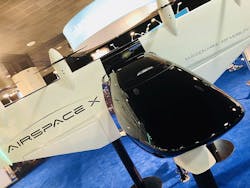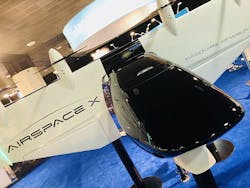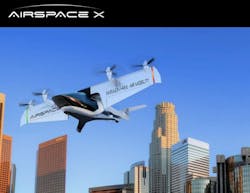AirSpaceX presents MOBi-ONE autonomous, electric VTOL aircraft at Detroit auto show
DETROIT. The MOBi-ONE autonomous, electric vertical take-off and landing (VTOL) aircraft from Airspace Experience Technologies LLC (AirSpaceX), a subsidiary of Detroit Aircraft Corp. (DAC) at the Coleman A. Young Municipal Airport in Detroit, Michigan, debuted at the North American International Auto Show (NAIAS) in Detroit this week. Advances in electric propulsion, automation, and lightweight materials now make the development of this new class of aircraft possible, company officials say.
MOBi-ONE is able to take off autonomously like a helicopter, fly like a plane, and transport passengers or cargo between urban centers, suburbs, and airports within 60 miles, officials say. MOBi-ONE leverages existing electric vehicle (EV) architecture and autonomous technologies to achieve a top flying speed of 250 miles per hour (MPH).
"MOBi-ONE will offer clean, quiet, and connected on-demand air mobility to the mass traveling public at an affordable price," says Jon Rimanelli, founder and CEO of Detroit Aircraft and AirSpaceX. "Our vision is to mass produce aircraft leveraging lean automotive design and mass production techniques so our vehicles are affordable to the mass traveling public."
"Our goal is to deploy 2,500 aircraft at the nation's 50 largest cities by 2026, targeting existing infrastructure at first," adds JP Yorro, chief commercial officer at AirSpaceX. "The MOBi development program will be capital intensive, but air Mobility as a Service could generate billions for the economy.”
Last year, U.S. drivers wasted an aggregate $300 billion in fuel and productivity sitting in traffic jams, yielding 38 billion pounds of carbon emissions. Not only is traffic taking over our lives, it is harming our environment, officials say.
"There is an urgent need for innovation in urban mobility, and I believe on-demand air mobility will go a long way toward reducing pressure on roads while improving the quality of life for commuters on the ground," Rimanelli explains.
MOBi-ONE was designed and built by Detroit Aircraft Corp. (DAC) at Detroit City Airport. AirSpaceX teamed with Camilo Pardo, chief designer of the 2005 and 2006 Ford GT, in MOBi-ONE's design. Pardo and Rimanelli began working together in 2011, prototyping and developing several VTOL concepts over the years.
"The evolution of these prototypes culminated in an iconic design with the MOBi-ONE. We wanted to create an aircraft with a unique appearance that stands alone and also reflects its function," Pardo says.
Upon completion of engineering packages, a full-scale aircraft will be manufactured, undergo Part 27 Certification, and be operated by AirSpaceX. The sub-scale MOBi-ONE was taken from clean sheet design, fabrication, and assembly in four weeks, officials say.
Founded in 2011 to design pilot-optional aircraft systems for military and commercial applications, DAC has designed and licensed a series of multi-rotor aircraft for commercial data collection and package delivery. DAC provided contract manufacturing, testing, marketing, sales, training, and MRO for a leading U.S. defense contractor, and has built more than 70 small electric VTOL aircraft since 2013. In 2015, DAC identified an automotive EV architecture making large-scale multi-rotor aircraft feasible for cargo and passenger transportation. AirSpaceX, a subsidiary of DAC, was founded to fund manufacturing and certification of MOBi-ONE.
The go-to resource for Intelligent Aerospace technology news & information:
Covering key topics
Across all market segments
Subscribe to the free Intelligent Inbox e-newsletter: http://www.intelligent-aerospace.com/subscribe.html.
Connect on social media:
Keep pace with aerospace innovation and opportunities via your favorite social media channels. Connect with Intelligent Aerospace on Twitter (@IntelligentAero), LinkedIn,Google+, and Instagram.



